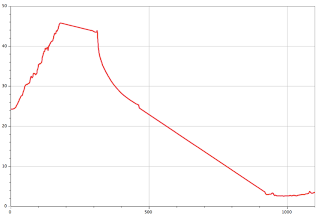The first time we attempted this lab, we did the measurements incorrectly. This caused the plug that was used to measure the gas pressure to pop off the test tube. This caused all the pressure to be released and ruin our graph. We then realized that we added to much yeast, and started over.
When we started over, we began with the acid test tube and measured the gas pressure for two minutes. The highest point was measured at 101kPa. Then next tube that was tested, was the neutral tube and this was the milk. The actual milk slightly rose when the yeast was introduced. The pressure, slowly rose and the highest point was 105.37kPa. After the neutral was measured, we measured the base, or antacid. This stayed the same physically. The highest pressure was measured at 101.6kPa. This is what the setup looked like while measuring the base test tube:
As you can see, all the labels were measured and the black plug is what measured the gas pressure. The Diet Coke is what was used as the acid. You can see this in the top left corner. This is what our graph looked like at the end of all three tests:
The blue line represents neutral. The green is base and the red is acid. Since neutral was the highest i accepted my hypothesis and the lab was a success.










